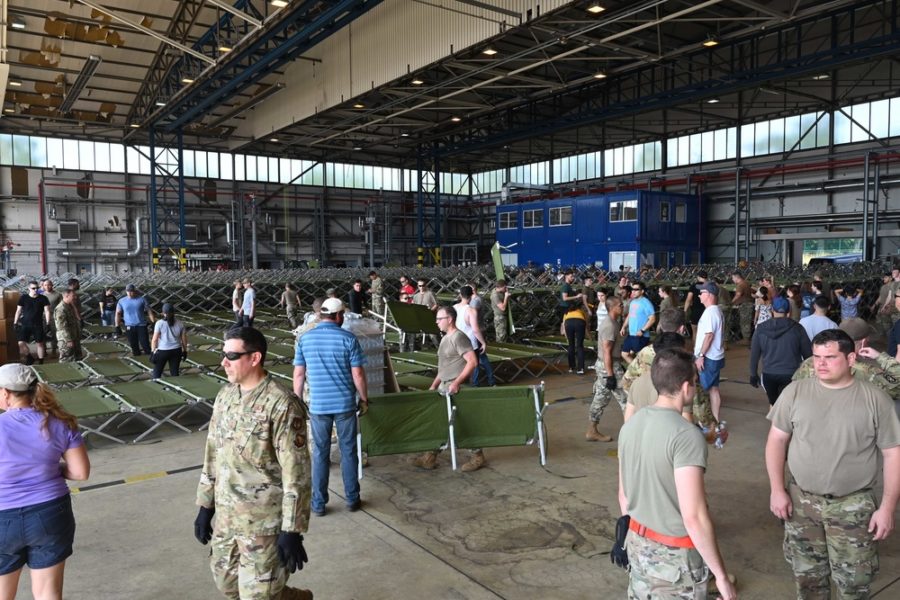U.S. bases across Europe are building up their capacity to temporarily house and screen Afghan evacuees fleeing Taliban rule, as the Aug. 31 deadline to withdrawal U.S. forces from Afghanistan looms.
So far, 82,300 people have been airlifted out of Afghanistan as part of the overall evacuation since Aug. 14. In a 24-hour period ending early Aug. 25, 90 aircraft departed Hamid Karzai International Airport in Kabul, including 37 U.S C-17s and five U.S. C-130s. This meant an aircraft was taking off once every 39 minutes.
Another 10,000 people were in the airport waiting for flights, as thousands more crowded the gates to the facility hoping to get through before U.S. forces leave.
“Our mission remains unchanged, said Maj. Gen. William D. “Hank” Taylor, the Joint Staff’s deputy director for regional operations in an Aug. 25 briefing. “For each day of this operation, we have carried out the direction of the President and the Secretary of Defense. Until that mission changes, we will continue to put forth our maximum effort to safely evacuate as many people as possible.”
U.S. bases in Europe, such as Ramstein Air Base, Germany, are increasing their capacity to bring on these evacuees. Once they arrive, evacuees are immediately given food, water, and shelter, said U.S. European Command boss Gen. Tod D. Wolters in an Aug. 25 briefing. Some of the arriving evacuees have required additional medical care.
Notably, an Afghan woman on Aug. 21 gave birth when a C-17 landed at Ramstein. Wolters said he spoke with the parents, and they named the baby girl “Reach” after the aircraft’s call sign for the flight.
“Being an Air Force fighter pilot, it’s my dream to watch that young child called Reach grow up to be a U.S. citizen and fly United States Air Force fighters in our Air Force,” Wolters said.
As of Aug. 25, Ramstein had 5,783 evacuees on base. Flights first arrived on Aug. 20, with follow-on flights taking evacuees to the continental United States starting on Aug. 23. To date, 1,605 evacuees have left Ramstein for the U.S.
Naval Air Station Sigonella, Italy, and Naval Station Rota, Spain, are beginning to take in personnel, with other locations across the continent preparing for possible arrivals. This includes Spangdahlem Air Base, Germany, and small Army posts in Germany and Kosovo, Wolters said.
Other USAF bases are sending personnel to help with the operations. For example, Airmen with the 48th Medical Group and security forces with the 501st Combat Support Wing at RAF Mildenhall, England, deployed to Ramstein to help. Aerial porters with the 728th Air Mobility Squadron at Incirlik Air Base, Turkey, deployed to Southwest Asia to help run port operations.
Wolters said the arriving evacuees are screened for COVID-19 and are beginning to be offered vaccinations when they arrive at Washington-Dulles International Airport. There are preliminary discussions to offer vaccines at the European bases.
The evacuees are also screened for security reasons, by both the U.S. military and the Department of Homeland Security. So far, 52 people have required additional screening and were then cleared.
Wolters said he expects the pace of arriving refugees at these bases to remain high as the evacuation continues.
“I believe the flow that we are going to embrace in the next 24 to 48 hours will be the flow that we can expect to see for the next several days,” Wolters said. “So, we are building to what I would say is a plateau that we are very, very close to getting to. And my sense is, obviously, as far as the machine is concerned, from what we get from the Middle East to here in Europe, we’re ready, willing, and able to accommodate that flow.”
Secretary of State Antony Blinken, in a separate Aug. 25 briefing, said his department estimates there were as many as 6,000 American citizens in Afghanistan who wanted to leave. Within the past 10 days, about 4,500 of them have left.
“For the remaining roughly 1,000 contacts we’ve had, who may be Americans seeking to leave Afghanistan, we’re aggressively reaching out to them, multiple times per day, through multiple channels of communication—phone, email, text messaging—to determine whether they still want to leave and get the most up-to-date information and instruction to them … on how to do so,” Blinken said. “Some may no longer be in the country, some may have claimed to be Americans but turn out not to be, some may choose to stay. We’ll continue to try to identify the status and plans of these people in the coming days.”
As the security situation in Kabul continues to deteriorate, U.S. commanders have directed additional missions outside the wire of HKIA to bring in people. This included a helicopter flight late Aug. 24 into Kabul to pick up “less than 20” individuals and fly them to the airport, Pentagon spokesman John F. Kirby said.
